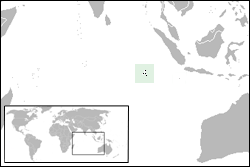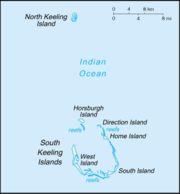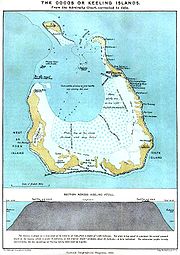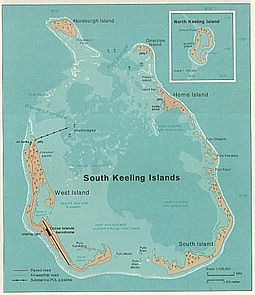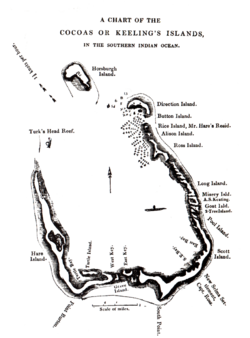
Cocos (Keeling) Islands
Background to the schools Wikipedia
This content from Wikipedia has been selected by SOS Children for suitability in schools around the world. Do you want to know about sponsoring? See www.sponsorachild.org.uk
|
Territory of the Cocos (Keeling) Islands
|
||||||
|---|---|---|---|---|---|---|
|
||||||
| Motto: Maju Pulu Kita | ||||||
|
The Cocos (Keeling) Islands are one of Australia's territories
|
||||||
| Capital | West Island | |||||
| Largest village | Bantam ( Home Island) | |||||
| Official languages | English ( de facto) | |||||
| Demonym | Cocossian (Cocos Islandian) | |||||
| Government | Federal constitutional monarchy | |||||
| - | Queen | Elizabeth II | ||||
| - | Administrator | Brian Lacy | ||||
| - | Shire President | Balmut Pirus | ||||
| Territory of Australia | ||||||
| - | Annexed by British Empire |
1857 |
||||
| - | Transferred to Australian control |
1955 |
||||
| Area | ||||||
| - | Total | 14 km2 5.3 sq mi |
||||
| - | Water (%) | 0 | ||||
| Population | ||||||
| - | July 2009 estimate | 596 ( n/a) | ||||
| - | Density | 43/km2 ( n/a) 112/sq mi |
||||
| Currency | Australian dollar ( AUD) |
|||||
| Time zone | ( UTC+6½) | |||||
| Calling code | 61 891 | |||||
| ISO 3166 code | CC | |||||
| Internet TLD | .cc | |||||
The Territory of Cocos (Keeling) Islands, also called Cocos Islands and Keeling Islands, is a territory of Australia, located in the Indian Ocean, southwest of Christmas Island and approximately midway between Australia and Sri Lanka. The territory consists of two atolls and twenty-seven coral islands, of which two, West Island and Home Island, are inhabited with a total population of approximately 600.
Geography
The Cocos (Keeling) Islands consist of two flat, low-lying coral atolls with an area of 14.2 square kilometres (5.5 sq mi), 26 kilometres (16 mi) of coastline, a highest elevation of 5 metres (16 ft) and thickly covered with coconut palms and other vegetation. The climate is pleasant, moderated by the southeast trade winds for about nine months of the year and with moderate rainfall. Cyclones may occur in the early months of the year.
North Keeling Island is an atoll consisting of just one C-shaped island, a nearly closed atoll ring with a small opening into the lagoon, about 50 metres (160 ft) wide, on the east side. The island measures 1.1 square kilometres (270 acres) in land area and is uninhabited. The lagoon is about 0.5 square kilometres (120 acres). North Keeling Island and the surrounding sea to 1.5 km (0.93 mi) from shore form the Pulu Keeling National Park, established on 12 December 1995. It is home to the only surviving population of the endemic, and endangered, Cocos Buff-banded Rail.
South Keeling Islands is an atoll consisting of twenty-four individual islets forming an incomplete atoll ring, with a total land area of 13.1 square kilometres (5.1 sq mi). Only Home Island and West Island are populated. The Cocos Malays maintain weekend shacks, referred to as pondoks, on most of the larger islands.
Table of the islets, with areas, numbered islets clockwise starting in the north:
| Nr. | Islet (Malay name) |
English name | Area (km²) |
|---|---|---|---|
| 1 | Pulau Luar | Horsburgh Island | 1.04 |
| 2 | Pulau Tikus | Direction Island | 0.34 |
| 3 | Pulau Pasir | Workhouse Island | 0.00 |
| 4 | Pulau Beras | Prison Island | 0.02 |
| 5 | Pulau Gangsa | Woeplace Islets | <0.01 |
| 6 | Pulau Selma | Home Island | 0.95 |
| 7 | Pulau Ampang Kechil | Scaevola Islet | <0.01 |
| 8 | Pulau Ampang | Canui Island | 0.06 |
| 9 | Pulau Wa-idas | Ampang Minor | 0.02 |
| 10 | Pulau Blekok | Goldwater Island | 0.03 |
| 11 | Pulau Kembang | Thorn Island | 0.04 |
| 12 | Pulau Cheplok | Gooseberry Island | <0.01 |
| 13 | Pulau Pandan | Misery Island | 0.24 |
| 14 | Pulau Siput | Goat Island | 0.10 |
| 15 | Pulau Jambatan | Middle Mission Isle | <0.01 |
| 16 | Pulau Labu | South Goat Island | 0.04 |
| 17 | Pulau Atas | South Island | 3.63 |
| 18 | Pulau Kelapa Satu | North Goat Island | 0.02 |
| 19 | Pulau Blan | East Cay | 0.03 |
| 20 | Pulau Blan Madar | Burial Island | 0.03 |
| 21 | Pulau Maria | West Cay | 0.01 |
| 22 | Pulau Kambling | Keelingham Horn Island | <0.01 |
| 23 | Pulau Panjang | West Island | 6.23 |
| 24 | Pulau Wak Bangka | ?Turtle Island | 0.22 |
| 25 | Gijs Peters | Cocos islands | 0.22 |
There are no rivers or lakes on either atoll. Fresh water resources are limited to water lenses on the larger islands, underground accumulations of rainwater lying above the seawater. These lenses are accessed through shallow bores or wells.
Cocos (Keeling) Island is located on almost exactly the opposite side of the globe from Cocos Island, Costa Rica.
Fauna
Demographics
In 2010, the population of the islands is estimated at just over 600. The population on the two inhabited islands generally is split between the ethnic Europeans on West Island (estimated population 100) and the ethnic Malays on Home Island (estimated population 500). A Cocos dialect of Malay and English are the main languages spoken, and 80% of Cocos Islanders are Sunni Muslim.
History
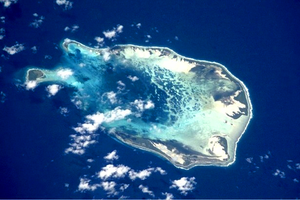
In 1609 Captain William Keeling was the first European to see the islands, but they remained uninhabited until the nineteenth century, when they became a possession of the Clunies-Ross Family. A Scottish merchant seaman named Captain John Clunies-Ross from the Shetland Islands explored the islands in 1825, aiming to settle on them with his family. Alexander Hare, who had taken part in Stamford Raffles' takeover of Java in 1811 landed and settled with his slaves who originated from Indonesia, the Cape of Good Hope and East Asia. Clunies-Ross returned and set up a compound on South Island consisting of his family and some other settlers. Hare's severely mistreated slaves soon escaped to work under better conditions for Clunies-Ross. The workers were paid in a currency called the Cocos rupee, a currency John Clunies-Ross minted himself that could only be redeemed at the company store.
On 1 April 1836, HMS Beagle under Captain Robert FitzRoy arrived to take soundings establishing the profile of the atoll as part of the survey expedition of the Beagle. To the young naturalist Charles Darwin, who was on the ship, the results supported a theory he had developed of how atolls formed. He studied the natural history of the islands and collected specimens. His assistant Syms Covington noted, "an Englishman [he was of course Scottish] and HIS family, with about sixty or seventy mulattos from the Cape of Good Hope, live on one of the islands. Captain Ross, the governor, is now absent at the Cape."
Annexed to the British Empire
The islands were annexed by the British Empire in 1857. This annexation was carried out by Captain Stephen Grenville Fremantle in command of HMS Juno. Fremantle claimed the islands for the British Empire and appointed Ross II as Superintendent. In 1867, their administration was placed under the Straits Settlements, which included Penang, Malacca and Singapore. Queen Victoria granted the islands in perpetuity to the Clunies-Ross family in 1886. The Cocos Islands under the Clunies-Ross family have been cited as an example of a nineteenth-century micronation.
World War I
On 9 November 1914, the islands became the site of the Battle of Cocos, one of the first naval battles of World War I. The wireless telegraph station on Direction Island, a vital link between the United Kingdom, Australia and New Zealand, was destroyed by sailors from the German light cruiser SMS Emden, which was in turn surprised and destroyed by the Australian cruiser, HMAS Sydney.
World War II
During World War II, the cable station was once again a vital link. Allied planners noted that the islands might be seized as a base for German raider cruisers operating in the Indian Ocean. Following Japan's entry into the war, Japanese forces did occupy neighbouring islands. To avoid drawing their attention to the Cocos cable station and its islands' garrison, the seaplane anchorage between Direction and Horsburgh islands was not used. Radio transmitters were also kept silent, except in emergencies.
After the Fall of Singapore in 1942, the islands were administered from Ceylon (Sri Lanka), and West and Direction Islands were placed under Allied military administration. The islands' garrison initially consisted of a platoon from the British Army's King's African Rifles, located on Horsburgh Island, with two 6-inch (152.4-millimetre) guns to cover the anchorage. The local inhabitants all lived on Home Island. Despite the importance of the islands as a communication centre, the Japanese made no attempt either to raid or to occupy them and contented themselves with sending over a reconnaissance aircraft about once a month.
On the night of 8–9 May 1942, fifteen members of the garrison, from the Ceylon Defence Force, mutinied, under the leadership of Gratien Fernando. The mutineers were said to have been provoked by the attitude of their British officers, and were also supposedly inspired by anti-imperialist beliefs. They attempted to take control of the gun battery on the islands. The Cocos Islands Mutiny was crushed, although the mutineers killed one non-mutinous soldier and wounded one officer. Seven of the mutineers were sentenced to death at a trial which was later alleged to have been improperly conducted. Four of the sentences were commuted, but three men were executed, including Fernando. These were to be the only British Commonwealth soldiers executed for mutiny during the Second World War.
On 25 December 1942, the Japanese submarine I-166 bombarded the islands but caused no damage.
Later in the war, two airstrips were built, and three bomber squadrons were moved to the islands to conduct raids against Japanese targets in South East Asia and to provide support during the planned reinvasion of Malaya and reconquest of Singapore. The first aircraft to arrive were Supermarine Spitfire Mk VIIIs of No. 136 Squadron RAF. They included some Liberator bombers from No. 321 (Netherlands) Squadron RAF (members of exiled Dutch forces serving with the Royal Air Force), which were also stationed on the islands. When in July 1945 No. 99 and No. 356 RAF squadrons arrived on West Island, they brought with them a daily newspaper called Atoll which contained news of what was happening in the outside world. Run by airmen in their off-duty hours, it achieved fame when dropped by Liberator bombers on POW camps over the heads of the Japanese guards. In 1946 the administration of the islands reverted to Singapore.
Transfer to Australia
On 23 November 1955, the islands were transferred to Australian control under the Cocos (Keeling) Islands Act 1955 (an Australian Act) pursuant to the Cocos Islands Act, 1955 (a UK Act). Mr H J Hull was appointed the first Official Representative (now Administrator) of the new Territory. He had been a Lieutenant- Commander in the Royal Australian Navy and was released for the purpose. Under Commonwealth Cabinet Decision 1573 of 9 September 1958, Mr Hull's appointment was terminated and John William Stokes was appointed on secondment from the Northern Territory Police. A media release at the end of October 1958 by the Minister for Territories, Mr Hasluck, commended Mr Hull's three years of service on Cocos. Mr Stokes served in the position from 31 October 1958 to 30 September 1960. Mr C.I. Buffett MBE from Norfolk Island succeeded him and served from 28 July 1960 to 30 June 1966, and later acted as Administrator back on Cocos and on Norfolk Island. In 1974, Ken Mullen wrote a small book about his time with wife and son from 1964 to 1966 working at the Cable Station on Direction Island.
In the 1970s, the Australian government's dissatisfaction with the Clunies-Ross feudal style of rule of the island increased. In 1978, Australia forced the family to sell the islands for the sum of AU$6,250,000, using the threat of compulsory acquisition. By agreement, the family retained ownership of Oceania House, their home on the island. However, in 1983 the Australian government reneged this agreement, and told John Clunies-Ross that he should leave the Cocos. The following year the High Court of Australia ruled that resumption of Oceania House was unlawful, but the Australian government ordered that no government business was to be granted to his shipping company, an action that contributed to his bankruptcy. John Clunies-Ross now lives in Perth, Western Australia. However, some members of the Clunies-Ross family still live on the Cocos.
Government
The capital of the Territory of Cocos (Keeling) Islands is West Island while the largest settlement is the village of Bantam ( Home Island). Governance of the islands is based on the Cocos (Keeling) Islands Act 1955 and depends heavily on the laws of Australia. The islands are administered from Canberra by the Attorney-General's Department (before 29 November 2007 administration was carried out by the Department of Transport and Regional Services), through a non-resident Administrator appointed by the Governor-General. The current Administrator is Brian Lacy, who was appointed on 18 September 2009 and is also the Administrator of Christmas Island. These two Territories comprise Australia's Indian Ocean Territories. There also exists a unicameral Cocos (Keeling) Islands Shire Council with seven seats. A full term lasts four years, though elections are held every two years; approximately half the members retire each two years. Federally, Cocos (Keeling) Islanders form the electorate of Lingiari with Christmas Island and outback Northern Territory.
The islands have a five-person police force but their defence remains the responsibility of Australia.
Economy
There is a small and growing tourist industry focused on water-based or nature activities.
Small local gardens and fishing contribute to the food supply, but most food and most other necessities must be imported from Australia or elsewhere.
The Cocos Islands Cooperative Society Ltd. employs construction workers, stevedores, and lighterage worker operations. Tourism employs others. The unemployment rate was 11.3% in 2006.
Communications and transport
The islands are connected within Australia's telecommunication system (with number range +61 8 9162 xxxx) and postal system ( post code: 6799). Public phones are located on both West Island and Home Island. A local digital mobile phone network operates on Cocos (Keeling) Islands. Phones must be registered through the Telecentre to access this service. There is one paved airport on the West Island, Cocos (Keeling) Island International Airport, to which Virgin Blue operates scheduled jet services from Perth, Western Australia. There is also a lagoon anchorage.
Education
There are two schools in the archipelago, located on the two inhabited islands. One is on West Island, and the other on Home Island.
School instruction is in English, and efforts are made to discourage students from speaking the local language ( Cocos Islands Malay, a Malay dialect) on school premises.


